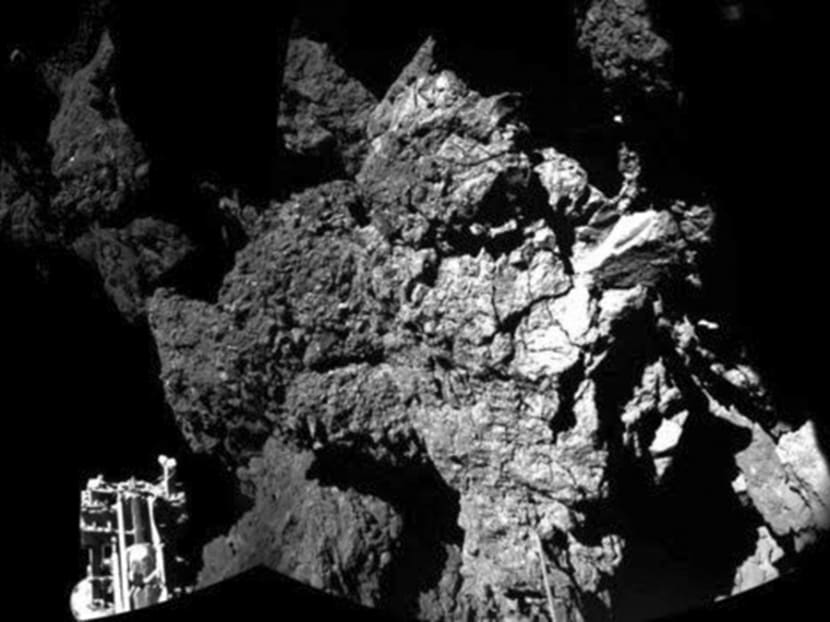Comet lander starts drilling; batteries a worry
BERLIN — The good news: The spacecraft that landed on a comet has begun drilling beneath the surface to see what secrets the celestial body can reveal.

The Philae lander is seen after it landed safely on a comet, known as 67P/Churyumov-Gerasimenko, in this CIVA handout image released Nov 13, 2014. Photo: Reuters
BERLIN — The good news: The spacecraft that landed on a comet has begun drilling beneath the surface to see what secrets the celestial body can reveal.
The bad news: Scientists at the European Space Agency still don’t know exactly where the lander is on the comet and are anxiously hoping its batteries hold out long enough for them to get the mining data and adjust the spacecraft’s position.
It was a race against time yesterday (Nov 14) for the Philae lander, which on Wednesday became the first spacecraft to touch down on a comet. Since then it has sent astonishing images from the icy, dusty comet, 67P/Churyumov-Gerasimenko, and generated some data from instruments such as one that measures temperatures.
All this is taking place 500 million km from Earth on a comet hurtling 66,000 kmh through space.
Material beneath the surface of the comet has remained almost unchanged for 4.5 billion years, making those mining samples a cosmic time capsule that scientists are eager to study.
Mission controllers said Philae was able to bore 25cm into the comet to start collecting the samples, but it’s unclear whether it has enough power to deliver any information on them.
The lander has an estimated 64 hours of battery power but has to rely on solar panels to generate electricity after that. Scientists were relieved to learn the batteries still had some juice when the lander resumed contact. Communication was reestablished, the ESA said in a tweet late last night.
“Lander now performing a ‘lift & turn’ of the main body on the landing gear — will last about 10 mins. Telecomm link is good,” the agency said in a second tweet.
Philae bounced twice on the comet before coming to rest Wednesday after two harpoons that should have anchored it to the surface failed to deploy. Controllers still haven’t been able to pinpoint its position, but photos indicate it’s next to a cliff that is largely blocking sunlight from reaching two of its three solar panels.
“Maybe the battery will be empty before we contact again,” said Dr Stephan Ulamec, head of operations for Philae.
If the batteries are still running and scientists can extract the scientific data from the craft, they will rotate the lander slightly so that it might capture more sunlight.
“That would increase the chance that, at a later stage, the lander could wake up again and start talking to us again,” DrUlamec said.
After the batteries run out, Philae will remain on the comet in a hibernation mode for the coming months. The comet is on a 6 1/2-year elliptical orbit around the sun. Philae could wake up again if the comet passes the sun in such a way that its solar panels catch more light.
Meanwhile, the Rosetta — Philae’s mother ship, which is streaking through space in tandem with the comet — will use its 11 instruments to analyse the comet over the coming months.
Scientists hope the US$1.6 billion (S$2.07 billion) project that was launched a decade ago will help them answer questions about the origins of the universe and life on Earth.
Communication with the lander is slow, with signals taking more than 28 minutes to travel between Earth and Rosetta.
No matter how long Philae keeps talking to them, scientists say they already have gathered huge amounts of data and are calling the expedition a roaring success.
“Let’s stop looking at things that we could have done if everything had worked properly,” said flight director Andrea Accomazzo. “Let us look at things that we have done, what we have achieved and what we have on the ground. This is unique and will be unique forever.”
As for pinpointing Philae’s position, Dr Holger Sierks, the principal investigator for the Rosetta’s camera systems, said the cameras should have captured the lander’s rebound, yielding valuable information on where it came to rest.
That data has not yet come in, however. Specialists still need to comb one and two sqkm on the comet to find Philae. AP





